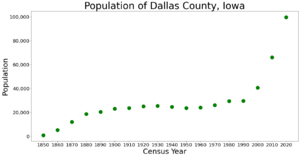Dallas County, Iowa facts for kids
Quick facts for kids
Dallas County
|
|
|---|---|
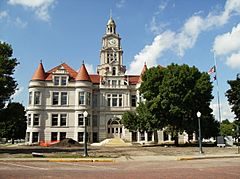
|
|
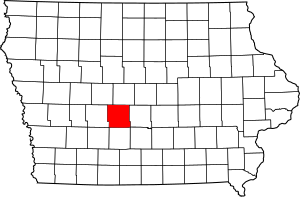
Location within the U.S. state of Iowa
|
|
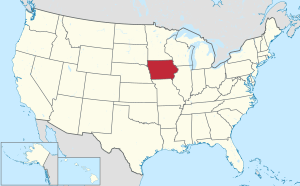 Iowa's location within the U.S. |
|
| Country | |
| State | |
| Founded | January 13, 1846 |
| Named for | George M. Dallas |
| Seat | Adel |
| Largest city | Waukee |
| Area | |
| • Total | 592 sq mi (1,530 km2) |
| • Land | 588 sq mi (1,520 km2) |
| • Water | 3.3 sq mi (9 km2) 0.5% |
| Population
(2020)
|
|
| • Total | 99,678 |
| • Density | 168.38/sq mi (65.01/km2) |
| Time zone | UTC−6 (Central) |
| • Summer (DST) | UTC−5 (CDT) |
| Congressional district | 3rd |
Dallas County is a county located in the U.S. state of Iowa. As of the 2020 Census, the population was 99,678, making it the seventh-most populous county in Iowa. Between 2010 and 2020, it was the fastest growing county in Iowa and one of the fastest growing in the country. Its county seat is Adel, and its largest city is Waukee. The county was named for George M. Dallas, Vice President of the United States under James K. Polk, the namesake of neighboring Polk County.
Dallas County is included in the Des Moines–West Des Moines, IA Metropolitan Statistical Area.
Contents
History
The land that now forms Dallas County was ceded by the Sac and Fox nation to the United States in a treaty signed on October 11, 1842.
On January 13, 1846, the legislative body of the Iowa Territory authorized the creation of twelve counties in the Iowa Territory, with general descriptions of their boundaries. Dallas County's name referred to United States Vice President George M. Dallas, who served from 1845 to 1849.
In 1847 the county residents voted to designate Penoch as the county seat (the name was changed to Adel in 1849). The county's population grew rapidly, with settlers coming to claim homesteads. By 1870, the population had crossed the 12,000 mark.
Geography
According to the United States Census Bureau, the county has a total area of 592 square miles (1,530 km2), of which 588 square miles (1,520 km2) is land and 3.3 square miles (8.5 km2) (0.5%) is water.
Major highways
 Interstate 80 – runs east-northeast across the southern portion of the county, passing Dexter and De Soto on its way to Des Moines
Interstate 80 – runs east-northeast across the southern portion of the county, passing Dexter and De Soto on its way to Des Moines U.S. Highway 6 – from its starting point in Adel, runs east across the midsection of the county on its way to Des Moines
U.S. Highway 6 – from its starting point in Adel, runs east across the midsection of the county on its way to Des Moines U.S. Highway 169 – runs north–south through the center of the county, from Bouton to Adel to De Soto
U.S. Highway 169 – runs north–south through the center of the county, from Bouton to Adel to De Soto Iowa Highway 17 – from its starting point (intersection with Iowa 141) at Granger, runs north along the county's eastern boundary, into Boone County
Iowa Highway 17 – from its starting point (intersection with Iowa 141) at Granger, runs north along the county's eastern boundary, into Boone County Iowa Highway 44 – runs east–west through the center of the county, through Dallas Center
Iowa Highway 44 – runs east–west through the center of the county, through Dallas Center Iowa Highway 141 – runs east across northern portion of county, through Dawson, Perry, Bouton and Woodward, then southeast to exit into Polk County at Granger
Iowa Highway 141 – runs east across northern portion of county, through Dawson, Perry, Bouton and Woodward, then southeast to exit into Polk County at Granger Iowa Highway 144 - from its starting point (intersection w Iowa 141) at Perry, runs north into Boone County
Iowa Highway 144 - from its starting point (intersection w Iowa 141) at Perry, runs north into Boone County Iowa Highway 210 – from its starting point (intersection w Iowa 141), runs north to Woodward and continues into Boone County
Iowa Highway 210 – from its starting point (intersection w Iowa 141), runs north to Woodward and continues into Boone County
Adjacent counties
- Adair County – southwest
- Boone County – north
- Greene County – north and northwest
- Guthrie County – west
- Madison County – south
- Polk County – east
- Warren County – southeast
Demographics
| Historical population | |||
|---|---|---|---|
| Census | Pop. | %± | |
| 1850 | 854 | — | |
| 1860 | 5,244 | 514.1% | |
| 1870 | 12,019 | 129.2% | |
| 1880 | 18,746 | 56.0% | |
| 1890 | 20,479 | 9.2% | |
| 1900 | 23,058 | 12.6% | |
| 1910 | 23,628 | 2.5% | |
| 1920 | 25,120 | 6.3% | |
| 1930 | 25,493 | 1.5% | |
| 1940 | 24,649 | −3.3% | |
| 1950 | 23,661 | −4.0% | |
| 1960 | 24,123 | 2.0% | |
| 1970 | 26,085 | 8.1% | |
| 1980 | 29,513 | 13.1% | |
| 1990 | 29,755 | 0.8% | |
| 2000 | 40,750 | 37.0% | |
| 2010 | 66,135 | 62.3% | |
| 2020 | 99,678 | 50.7% | |
| 2023 (est.) | 111,092 | 68.0% | |
| U.S. Decennial Census 1790-1960 1900-1990 1990-2000 2010-2018 |
|||
2020 census
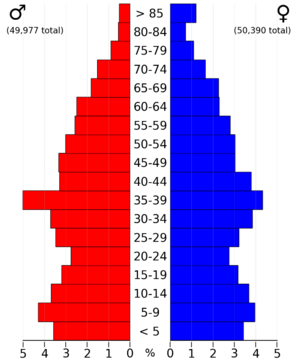
The 2020 census recorded a population of 99,678 in the county, with a population density of 168.7353/sq mi (65.1491/km2). 94.19% of the population reported being of one race. There were 41,125 housing units of which 38,291 were occupied.
| Race | Num. | Perc. |
|---|---|---|
| White (NH) | 81,708 | 82% |
| Black or African American (NH) | 2,657 | 2.7% |
| Native American (NH) | 137 | 0.14% |
| Asian (NH) | 4,987 | 5% |
| Pacific Islander (NH) | 32 | 0.03% |
| Other/Mixed (NH) | 3,642 | 3.7% |
| Hispanic or Latino | 6,515 | 6.54% |
2010 census
The 2010 census recorded a population of 66,135 in the county, with a population density of 112.7698/sq mi (43.5407/km2). There were 27,260 housing units, of which 25,240 were occupied.
Communities
Cities
- ‡ partly in Polk County
Unincorporated communities
Townships
- Adams
- Adel
- Beaver
- Boone
- Colfax
- Dallas
- Des Moines
- Grant
- Lincoln
- Linn
- Spring Valley
- Sugar Grove
- Union
- Van Meter
- Walnut
- Washington
Population ranking
The population ranking of the following table is based on the 2020 census of Dallas County.
† county seat
| Rank | City/Town/etc. | Municipal type | Population (2020 Census) |
|---|---|---|---|
| 1 | West Des Moines (mostly in Polk County) | City | 68,723 |
| 2 | Urbandale (partially in Polk County) | City | 45,580 |
| 3 | Waukee | City | 23,940 |
| 4 | Clive (partially in Polk County) | City | 18,601 |
| 5 | Grimes (mostly in Polk County) | City | 15,392 |
| 6 | Perry | City | 7,836 |
| 7 | † Adel | City | 6,153 |
| 8 | Dallas Center | City | 1,901 |
| 9 | Granger (partially in Polk County) | City | 1,654 |
| 10 | Van Meter | City | 1,484 |
| 11 | Woodward | City | 1,346 |
| 12 | De Soto | City | 915 |
| 13 | Redfield | City | 731 |
| 14 | Dexter | City | 640 |
| 15 | Minburn | City | 325 |
| 16 | Linden | City | 200 |
| 17 | Dawson | City | 116 |
| 18 | Bouton | City | 127 |
See also
 In Spanish: Condado de Dallas (Iowa) para niños
In Spanish: Condado de Dallas (Iowa) para niños


